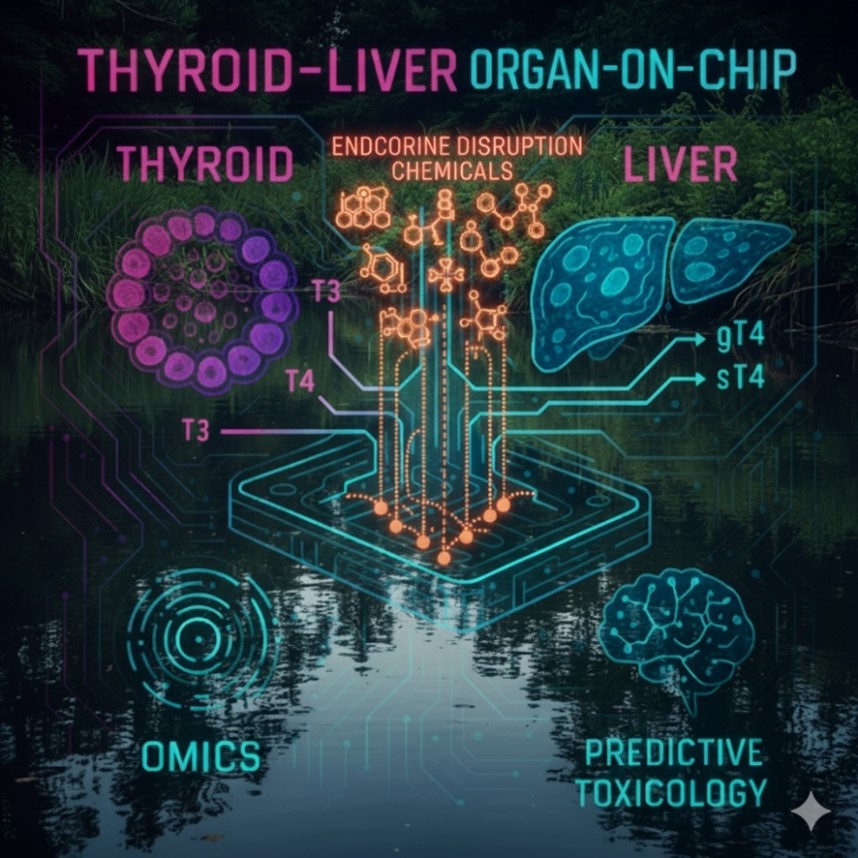PhD – Human Thyroid–Liver Organ-on-Chip Platform
Job Overview
-
Date PostedOctober 24, 2025
-
-
Expiration dateJanuary 7, 2026
-
Job Description
2026-B30 Assessing Environmental Endocrine Disruptors with a Human Thyroid–Liver Organ-on-Chip Platform
PROJECT HIGHLIGHTS
- Human Health and Environmental Pollution: Development of a human-relevant thyroid–liver organ-on-chip platform to assess endocrine disruption driven by environmental contaminants.
- Systems-Level Environmental Toxicology: Integration of omics and systems toxicology approaches to identify mechanistic biomarkers and predictive pathways of disruption.
- Environmental Protection and Sustainability: Advancement of animal-free methods next-generation environmental chemical risk assessment to safeguard ecosystems and human health.
Overview
This PhD project aims to develop a human thyroid–liver organ-on-a-chip (OoC) platform to investigate how environmental chemical pollutants disrupt endocrine function, with a focus on thyroid hormone disruption. By integrating omics and systems toxicology approaches, the project will provide a physiologically relevant, mechanistic alternative to animal-based testing, directly addressing the environmental challenge of precisely assessing endocrine-disrupting chemicals (EDCs) released into air, water, soil, and food chains. The key research questions include: 1) How can a microphysiological thyroid–liver chip be optimised to capture hormone production, transport, and metabolism in a human-relevant context that reflects environmentally mediated exposure? 2) Can this platform accurately model disruption of thyroid hormone homeostasis by environmental contaminants, including mixtures, and identify mechanistic biomarkers of endocrine disruption? 3) How can omics and systems toxicology approaches be integrated to predict environmentally relevant adverse outcomes and support next-generation chemical safety assessment?
To achieve these goals, the project will develop thyroid organoids with follicular structure and thyroid-stimulating hormone (TSH)-dependent hormone production, co-cultured with liver organoids capable of phase I/II metabolism and thyroid hormone clearance. These models will be integrated into a microfluidic chip to simulate inter-organ crosstalk and dynamic hormone regulation. A panel of environmentally relevant chemicals and mixtures will be applied to evaluate dose–response effects and mechanisms of thyroid disruption. High-throughput omics technologies (e.g. transcriptomics, metabolomics, proteomics) will characterise molecular responses.
The anticipated outcomes of this research include the development of a reproducible and mechanistically informative thyroid–liver chip that can serve as a viable New Approach Methodology (NAM) for environmental toxicology, advancing the 3Rs (Replacement, Reduction, Refinement) in animal use. Academically, the project will contribute to organ-on-chip innovation, endocrine disruption research, and systems-level toxicology, generating high-impact publications and international conference presentations. Beyond academia, the platform will have significant regulatory and industrial applications, with potential use in environmental toxicology, environmental risk assessment, and policy development for pollution control.
The project will be structured for 3.5 years: the first year will focus on literature review, organoid optimisation, and chip design; the second year will involve establishing co-culture models, functional validation, and chemical testing; and the final year will emphasise omics integration, systems modelling, regulatory discussions, and thesis preparation. By the end of the PhD, this research aims to deliver a validated thyroid–liver chip platform for predictive, mechanistically informed assessment of environmental endocrine disruptors.
Figure 1: Thyroid-Liver Organ-on-Chip Platform for Assessment of Thyroid Disruption Induced by Environmental Pollutants.

This project is a CENTA Flagship Project.
Case funding
This project is suitable for CASE funding
Host
- University of Birmingham
Theme
- Climate and Environmental Sustainability, Organisms and Ecosystems
Supervisors
Project investigator
- Pu Xia, p.xia@bham.ac.uk
Co-investigators
- Zhiling Guo, University of Birmingham, z.guo@bham.ac.uk; Helen Tinwell, Bayer Crop Science, helen.tinwell@bayer.com
How to apply
Each host has a slightly different application process.
Find out how to apply for this studentship.
All applications must include the CENTA application form.
Choose your application route
Human thyroid organoids will be developed to form follicular structures with TSH-dependent triiodothyronine (T3) and thyroxine (T4) production. In parallel, liver organoids (HepaRG or iPSC-derived hepatocytes) will be optimised to provide thyroid hormone clearance through phase I/II metabolism, generating glucuronidated and sulfated thyroxine. These modules will be integrated into a microfluidic chip under dynamic flow to replicate physiological crosstalk between hormone synthesis, binding, and metabolism. A panel of environmental chemicals and mixtures, will be applied to evaluate dose–response effects on hormone homeostasis. High-throughput omics approaches (e.g. transcriptomics, metabolomics, proteomics) will characterise molecular pathways of disruption. Finally, systems toxicology modelling, such as AOPs, will integrate data into predictive frameworks for environmental risk assessment.
Further details and How to Apply
For any enquiries related to this project please contact Pu Xia, p.xia@bham.ac.uk
To apply to this project:
- You must include a CENTA studentship application form, downloadable from: CENTA Studentship Application Form 2026.
- You must include a CV with the names of at least two referees (preferably three) who can comment on your academic abilities.
- Please submit your application and complete the host institution application process via: https://sits.bham.ac.uk/lpages/LES068.htm. Please select the PhD Bioscience (CENTA) 2026/27 Apply Now button. The CENTA Studentship Application Form 2026 and CV can be uploaded to the Application Information section of the online form. Please quote 2026-B30 when completing the application form.
Applications must be submitted by 23:59 GMT on Wednesday 7th January 2026.




